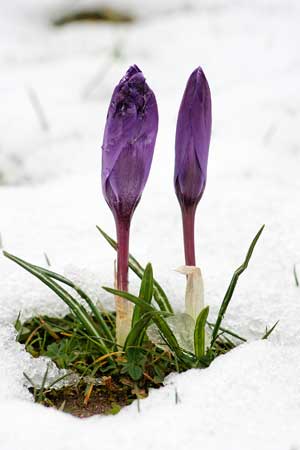The calendar claims the first day of spring is March 21st. However, that is not necessarily the first spring day. After months of white and gray gloom, most of us are ready to celebrate the sights and sounds of the next season. Runner Doug Larson noted that “spring is when you feel like whistling even with a shoe full of slush.”
 |
“First a howling blizzard woke us,
Then the rain came down to soak us,
And now before the eye can focus
- Crocus.” ~Lilja Rogers.
Wikimedia commons photo. |
American Robins were traditionally considered harbingers of spring. However, nowadays, “robin numbers rank very close to the top for one of the most abundant species” on New England bird counts conducted in the heart of winter (source: 109th Christmas Bird Count Summary.)
For forester and Eastford resident Steve Broderick, a better harbinger is the sight of maple trees tapped for syrup. For my husband Doug, it is the vernal pool that springs forth in our basement. I find myself yearning for a Phoebe’s call, Goldfinches transitioning to canary yellow mode, and even for hoards of Red-winged Blackbirds and Grackles overwhelming my birdfeeders. My neighbor Joe has come up with this list of indicators he eagerly awaits.
Birds calling. Hormones surge, triggering avian territorial impulses and courtship. In February you start to hear Pileated Woodpeckers calling to each other from deep in the woods. Pterodactyl sized Red-tailed Hawks cry out as they soar the skies. Owls call more frequently at night. The Great Horned Owl is one of the first birds to nest. In some areas, they have already laid eggs by the middle of February.
Birds circling. Resident Turkey Vultures become more visible, wheeling on the updrafts. Their numbers swell as migrants depart from Florida in March and April.
Birds house hunting. The male bluebird’s soft warble signals the awakening of spring. Overwintering residents and returning migrants pair off. Couples pop in and out of nestboxes as they check out potential nesting sites on sunny days in mid-February.
Birds disappearing, mammals reappearing The Dark-eyed Juncos that crowded our feeders all winter long head north. These seasonal visitors are mostly gone by mid-March. Chipmunks bound along stonewalls.
Plants popping up. Crocuses and daffodils poke through the snow. They first appear near stonewalls or the foundations of houses, where the ground is warmer. As the ice thaws, fleshy leaves hooding the spongy flower head of the Skunk Cabbage pop up in swampy areas. This pungent plant has the jump on other spring flowers because it is capable of generating its own heat. During flowering, metabolic processes maintain its temperature as high as 68 degrees F, even when it is freezing outside.
Peepers. Marshmallow peeps hatch on grocery store shelves. Outside, spring peepers commence their night chorus. Breeding season begins soon after the spring ice melt. By the time you hear the trill of an American Toad, you are into warmer weather in April.
|

